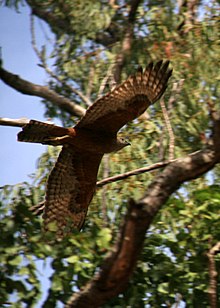Red goshawk
| Red goshawk | |
|---|---|
 |
|
| Scientific classification | |
| Kingdom: | Animalia |
| Phylum: | Chordata |
| Class: | Aves |
| Order: | Accipitriformes |
| Family: | Accipitridae |
| Genus: | Erythrotriorchis |
| Species: | E. radiatus |
| Binomial name | |
|
Erythrotriorchis radiatus (Latham, 1801) |
|
The red goshawk (Erythrotriorchis radiatus) is probably the rarest Australian bird of prey. It is found mainly in the savanna woodlands of northern Australia, particularly near watercourses. It takes a broad range of live prey, mostly birds.
The red goshawk was first described by the English ornithologist John Latham in 1801 under the binomial name Falco radiatus.
The species used to be regarded as a very large member of the goshawk subfamily, Accipitrinae, but it is now believed that the resemblance to these other birds is convergent. Experts now group the red goshawk with the superficially dissimilar black-breasted buzzard Hamirostra melanosternon and square-tailed kite Lophoictinia isura as one of the Australasian old endemic raptors. It is believed that the ancestors of these birds, possibly together with a handful of species from South-east Asia and Africa, occupied Gondwana and over millions of years have diverged into their current forms.
Gene sequencing studies have found a relationship between Hamirostra and Lophoictinia, however samples had not been obtained from Erythrotriorchis.
Plumage is generally rufous; on the head streaked with black and white, having more white on the face and throat; on the upper surfaces (body and upperwings) marked with black. Flight feathers and tail are barred grey, dark above and light below. Underside (belly and underwing coverts) are rufous with slight black ticking. The female has a paler belly than the male. Juveniles (first year) have less streaking on the head.
Adults have yellow irides (brown to yellow in the male); juveniles brown. The cere and skin around the eye vary from pale-blue in the juvenile through pale blue-grey to pale-grey in the adult. Adults' legs and feet are yellow; juveniles are pale grey, cream, or pale yellow.
Wings are long, broad and fingered at the tips. Its long wings are unlike the short wings of the Accipiter goshawks. Its tail is long and broad; square-tipped and about half its total length. It has a robust bill, slight brow ridge, and very heavy feet with bare tarsi having scutellate scale pattern.
...
Wikipedia

